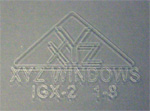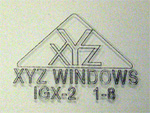23 January 2009
Alternate Glass Marking Method using Synrad CO2 Lasers
 With hundreds of Synrad CO2 lasers and FH Series marking heads installed on production lines in major glass manufacturing facilities throughout the world, Synrad know a thing or two about glass marking. In this article, another method of laser marking glass is described that allows laser marks to be created in black or in many other colours.
With hundreds of Synrad CO2 lasers and FH Series marking heads installed on production lines in major glass manufacturing facilities throughout the world, Synrad know a thing or two about glass marking. In this article, another method of laser marking glass is described that allows laser marks to be created in black or in many other colours.
The first photo illustrates a typical 10 watt glass mark, in this case, a logo from an imaginary glass company—the XYZ Window Corporation. This type of mark is by far the most common, a subtle yet readable mark usually seen in the corner of window panes or door glass. The XYZ logo was created in Synrad’s WinMark Pro laser marking software by creating two separate text objects and then importing a vector graphic file. In this example, the following mark parameters were set for the first Mark Pass: Velocity – 25 inches per second (IPS), Power – 10 watts, Resolution – 300, Spot Marking Style – Yes, and a Spot Mark Duration of 5 (0.5 ms). Two more Mark Passes were then made, changing only the Power setting to 12 watts. By using a 125 mm focusing lens with a 180-micron (0.007”) focused spot, the ring fractures were controlled and contained to diameters of 200–300 microns. This particular chip-free logo, measuring 45 mm × 35 mm (1.8” × 1.4”), was produced with 10 to 12 watts of power in a cycle time of 7.51 seconds.
In cases where a more distinct mark is required (to replace a silk-screened mark on automotive door glass for example) or when creating customised art on glass, the use of proprietary coatings can be used. These coatings, available in several colours, are applied to the substrate (glass, metal, plastic. etc.) prior to marking and then fused to the material surface by the intense heat of the laser’s focused beam, resulting in a permanent bond.
 The second photo shows the XYZ Window logo after marking another piece of soda-lime float glass. A black coating was chosen (available in an aerosol spray), applied to the glass and then allowed a few minutes drying time. In the mark file, the Velocity was changed to 16 IPS, Power to 30 watts, and set Spot Marking Style to No so that continuous vector lines were marked instead of discrete spots. Because the coating is bonded to the glass surface without inducing fracturing, the Mark Passes property was set to 1. Using these settings to mark the same 45 mm × 35 mm logo, the high-visibility mark shown was achieved at a power level of 30 watts in a cycle time of only 1.97 seconds.
The second photo shows the XYZ Window logo after marking another piece of soda-lime float glass. A black coating was chosen (available in an aerosol spray), applied to the glass and then allowed a few minutes drying time. In the mark file, the Velocity was changed to 16 IPS, Power to 30 watts, and set Spot Marking Style to No so that continuous vector lines were marked instead of discrete spots. Because the coating is bonded to the glass surface without inducing fracturing, the Mark Passes property was set to 1. Using these settings to mark the same 45 mm × 35 mm logo, the high-visibility mark shown was achieved at a power level of 30 watts in a cycle time of only 1.97 seconds.
By setting power levels between 20–25 watts and velocities of 24–32 IPS, this same process can be used to mark large, decorative bitmap images on glass using a 370 mm lens (0.021” focused spot) over an area as large as 241 mm × 297 mm (9.5" × 11.7"). When raster-scanning bitmap images, lower powers at higher speeds create the same permanent bond without heating the glass to a point where uncontrolled fracturing occurs.
- Contact Information
- Name: Gary Broadhead
- Email: garyb@laserlines.co.uk

